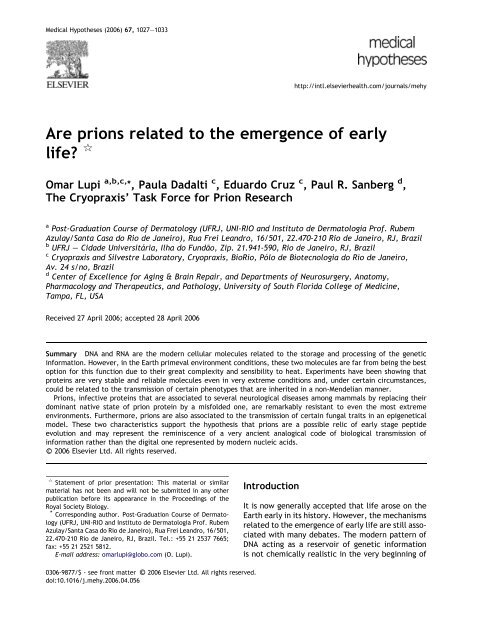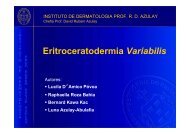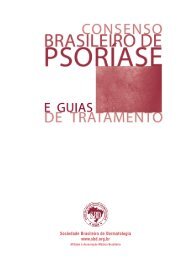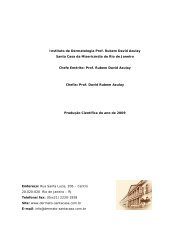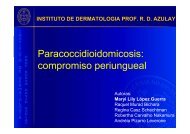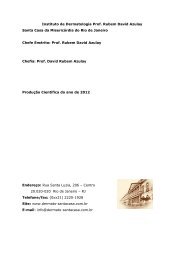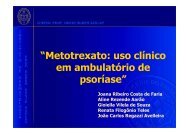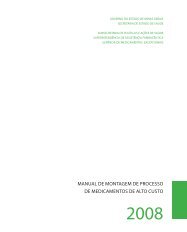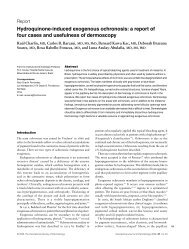Are prions related to the emergence of early life? - instituto de ...
Are prions related to the emergence of early life? - instituto de ...
Are prions related to the emergence of early life? - instituto de ...
You also want an ePaper? Increase the reach of your titles
YUMPU automatically turns print PDFs into web optimized ePapers that Google loves.
Medical Hypo<strong>the</strong>ses (2006) 67, 1027–1033<br />
<strong>Are</strong> <strong>prions</strong> <strong>related</strong> <strong>to</strong> <strong>the</strong> <strong>emergence</strong> <strong>of</strong> <strong>early</strong><br />
<strong>life</strong>? q<br />
Omar Lupi a,b,c, *, Paula Dadalti c , Eduardo Cruz c , Paul R. Sanberg d ,<br />
The Cryopraxis’ Task Force for Prion Research<br />
a<br />
Post-Graduation Course <strong>of</strong> Derma<strong>to</strong>logy (UFRJ, UNI-RIO and Institu<strong>to</strong> <strong>de</strong> Derma<strong>to</strong>logia Pr<strong>of</strong>. Rubem<br />
Azulay/Santa Casa do Rio <strong>de</strong> Janeiro), Rua Frei Leandro, 16/501, 22.470-210 Rio <strong>de</strong> Janeiro, RJ, Brazil<br />
b<br />
UFRJ – Cida<strong>de</strong> Universitária, Ilha do Fundão, Zip. 21.941-590, Rio <strong>de</strong> Janeiro, RJ, Brazil<br />
c<br />
Cryopraxis and Silvestre Labora<strong>to</strong>ry, Cryopraxis, BioRio, Pólo <strong>de</strong> Biotecnologia do Rio <strong>de</strong> Janeiro,<br />
Av. 24 s/no, Brazil<br />
d<br />
Center <strong>of</strong> Excellence for Aging & Brain Repair, and Departments <strong>of</strong> Neurosurgery, Ana<strong>to</strong>my,<br />
Pharmacology and Therapeutics, and Pathology, University <strong>of</strong> South Florida College <strong>of</strong> Medicine,<br />
Tampa, FL, USA<br />
Received 27 April 2006; accepted 28 April 2006<br />
Summary DNA and RNA are <strong>the</strong> mo<strong>de</strong>rn cellular molecules <strong>related</strong> <strong>to</strong> <strong>the</strong> s<strong>to</strong>rage and processing <strong>of</strong> <strong>the</strong> genetic<br />
information. However, in <strong>the</strong> Earth primeval environment conditions, <strong>the</strong>se two molecules are far from being <strong>the</strong> best<br />
option for this function due <strong>to</strong> <strong>the</strong>ir great complexity and sensibility <strong>to</strong> heat. Experiments have been showing that<br />
proteins are very stable and reliable molecules even in very extreme conditions and, un<strong>de</strong>r certain circumstances,<br />
could be <strong>related</strong> <strong>to</strong> <strong>the</strong> transmission <strong>of</strong> certain phenotypes that are inherited in a non-Men<strong>de</strong>lian manner.<br />
Prions, infective proteins that are associated <strong>to</strong> several neurological diseases among mammals by replacing <strong>the</strong>ir<br />
dominant native state <strong>of</strong> prion protein by a misfol<strong>de</strong>d one, are remarkably resistant <strong>to</strong> even <strong>the</strong> most extreme<br />
environments. Fur<strong>the</strong>rmore, <strong>prions</strong> are also associated <strong>to</strong> <strong>the</strong> transmission <strong>of</strong> certain fungal traits in an epigenetical<br />
mo<strong>de</strong>l. These two characteristics support <strong>the</strong> hypo<strong>the</strong>sis that <strong>prions</strong> are a possible relic <strong>of</strong> <strong>early</strong> stage pepti<strong>de</strong><br />
evolution and may represent <strong>the</strong> reminiscence <strong>of</strong> a very ancient analogical co<strong>de</strong> <strong>of</strong> biological transmission <strong>of</strong><br />
information ra<strong>the</strong>r than <strong>the</strong> digital one represented by mo<strong>de</strong>rn nucleic acids.<br />
c 2006 Elsevier Ltd. All rights reserved.<br />
q Statement <strong>of</strong> prior presentation: This material or similar<br />
material has not been and will not be submitted in any o<strong>the</strong>r<br />
publication before its appearance in <strong>the</strong> Proceedings <strong>of</strong> <strong>the</strong><br />
Royal Society Biology.<br />
* Corresponding author. Post-Graduation Course <strong>of</strong> Derma<strong>to</strong>logy<br />
(UFRJ, UNI-RIO and Institu<strong>to</strong> <strong>de</strong> Derma<strong>to</strong>logia Pr<strong>of</strong>. Rubem<br />
Azulay/Santa Casa do Rio <strong>de</strong> Janeiro), Rua Frei Leandro, 16/501,<br />
22.470-210 Rio <strong>de</strong> Janeiro, RJ, Brazil. Tel.: +55 21 2537 7665;<br />
fax: +55 21 2521 5812.<br />
E-mail address: omarlupi@globo.com (O. Lupi).<br />
0306-9877/$ - see front matter c 2006 Elsevier Ltd. All rights reserved.<br />
doi:10.1016/j.mehy.2006.04.056<br />
Introduction<br />
http://intl.elsevierhealth.com/journals/mehy<br />
It is now generally accepted that <strong>life</strong> arose on <strong>the</strong><br />
Earth <strong>early</strong> in its his<strong>to</strong>ry. However, <strong>the</strong> mechanisms<br />
<strong>related</strong> <strong>to</strong> <strong>the</strong> <strong>emergence</strong> <strong>of</strong> <strong>early</strong> <strong>life</strong> are still associated<br />
with many <strong>de</strong>bates. The mo<strong>de</strong>rn pattern <strong>of</strong><br />
DNA acting as a reservoir <strong>of</strong> genetic information<br />
is not chemically realistic in <strong>the</strong> very beginning <strong>of</strong>
1028 Lupi et al.<br />
<strong>life</strong> in our planet. DNA carries <strong>the</strong> genetic information<br />
required for <strong>the</strong> syn<strong>the</strong>sis <strong>of</strong> proteins. The replication<br />
and transcription <strong>of</strong> DNA require a complex<br />
set <strong>of</strong> enzymes and o<strong>the</strong>r proteins. Even <strong>the</strong> shortest<br />
DNA strand needs proteins <strong>to</strong> help it replicate.<br />
How <strong>the</strong>n could <strong>the</strong> first living cells with DNA-based<br />
molecular biology have originated by spontaneous<br />
chemical processes on <strong>the</strong> prebiotic Earth? Primordial<br />
DNA syn<strong>the</strong>sis would have required <strong>the</strong> presence<br />
<strong>of</strong> specific enzymes, but how could <strong>the</strong>se<br />
enzymes be syn<strong>the</strong>sized without <strong>the</strong> genetic information<br />
in DNA and without RNA for translating that<br />
information in<strong>to</strong> <strong>the</strong> amino acid sequence <strong>of</strong> <strong>the</strong><br />
protein enzymes? In o<strong>the</strong>r words, proteins are required<br />
for DNA syn<strong>the</strong>sis and DNA is required for<br />
protein syn<strong>the</strong>sis. Fur<strong>the</strong>rmore, DNA’s chemical<br />
great complexity and sensibility <strong>to</strong> heat make<br />
DNA probably a late sophistication <strong>of</strong> <strong>the</strong> cell<br />
mechanism <strong>of</strong> self-replication and transmission <strong>of</strong><br />
genetic information in a very reliable way.<br />
RNA World<br />
Many scholars consi<strong>de</strong>r RNA as a much more suitable<br />
molecule <strong>to</strong> be <strong>related</strong> <strong>to</strong> <strong>early</strong> <strong>life</strong>. The term<br />
‘‘RNA World’’ was first used by Walter Gilbert in<br />
1986 [1]. The RNA World hypo<strong>the</strong>sis is supported<br />
by <strong>the</strong> RNA’s ability <strong>to</strong> s<strong>to</strong>re, transmit, and duplicate<br />
genetic information, just like DNA does. RNA<br />
can also act as a ribozyme, an enzyme ma<strong>de</strong> <strong>of</strong><br />
ribonucleic acid. Because it can reproduce on its<br />
own, performing <strong>the</strong> tasks <strong>of</strong> both DNA and proteins<br />
(enzymes), RNA is believed <strong>to</strong> have once been<br />
capable <strong>of</strong> in<strong>de</strong>pen<strong>de</strong>nt <strong>life</strong> and some RNA-viruses<br />
may represent a si<strong>de</strong> effect <strong>of</strong> this capability.<br />
Experiments with basic ribozymes, like <strong>the</strong> viral<br />
RNA Q-beta, have shown that simple self-replicating<br />
RNA structures can withstand even strong selective<br />
pressures [2,3].<br />
Competition between RNA may have favored <strong>the</strong><br />
<strong>emergence</strong> <strong>of</strong> cooperation between different RNA<br />
chains, opening <strong>the</strong> way for <strong>the</strong> formation <strong>of</strong> <strong>the</strong><br />
first pro<strong>to</strong>-cell [2,4]. Eventually, RNA chains randomly<br />
<strong>de</strong>veloped with catalytic properties that help<br />
amino acids bind <strong>to</strong>ge<strong>the</strong>r (pepti<strong>de</strong>-bonding). These<br />
amino acids could <strong>the</strong>n assist with RNA syn<strong>the</strong>sis,<br />
giving those RNA chains that could serve as ribozymes<br />
<strong>the</strong> selective advantage. According <strong>to</strong> this<br />
hypo<strong>the</strong>sis, eventually DNA, lipids, carbohydrates,<br />
and all sorts <strong>of</strong> o<strong>the</strong>r chemicals were recruited in<strong>to</strong><br />
<strong>life</strong> [2–4]. Forterre [5] believes that RNA-viruses<br />
played a critical role in major evolutionary transitions,<br />
such as <strong>the</strong> invention <strong>of</strong> DNA and DNA replication<br />
mechanisms. This led <strong>to</strong> <strong>the</strong> first prokaryotic<br />
cells, and eventually <strong>to</strong> <strong>life</strong> as we know it.<br />
The ‘‘RNA World’’ hypo<strong>the</strong>sis was given a major<br />
boost with <strong>the</strong> <strong>de</strong>ciphering <strong>of</strong> <strong>the</strong> three-dimensional<br />
structure <strong>of</strong> <strong>the</strong> ribosome, which revealed<br />
<strong>the</strong> key catalytic sites <strong>of</strong> ribosomes <strong>to</strong> be composed<br />
<strong>of</strong> RNA, with proteins playing only a structural role<br />
in holding <strong>the</strong> ribosomal RNA <strong>to</strong>ge<strong>the</strong>r [6,7]. Specifically,<br />
<strong>the</strong> formation <strong>of</strong> <strong>the</strong> pepti<strong>de</strong> bond, <strong>the</strong><br />
reaction that binds amino acids <strong>to</strong>ge<strong>the</strong>r in<strong>to</strong> proteins,<br />
is now known <strong>to</strong> be catalyzed by RNA [6,7].<br />
This finding suggests that RNA molecules were most<br />
likely capable <strong>of</strong> generating <strong>the</strong> first proteins [8].<br />
However, <strong>the</strong> ‘‘RNA World’’ hypo<strong>the</strong>sis seems<br />
implausible because, in <strong>to</strong>day’s world, large RNA<br />
molecules are inherently fragile and can easily be<br />
broken down in<strong>to</strong> <strong>the</strong>ir constituent nucleoti<strong>de</strong>s<br />
with hydrolysis [9]. Even without hydrolysis RNA<br />
will eventually break down from background radiation<br />
[10,11] and <strong>the</strong> environmental conditions in<br />
prebiotic Earth were very hardy [11]. Many o<strong>the</strong>r<br />
chemical difficulties, such as <strong>the</strong> fact that cy<strong>to</strong>sine<br />
does not have a plausible prebiotic simulation<br />
method because it easily un<strong>de</strong>rgoes hydrolysis<br />
and <strong>the</strong> observation that in prebiotic simulations<br />
making nucleoti<strong>de</strong>s have conditions incompatible<br />
with those for making sugars, led many scholars<br />
<strong>to</strong> believe that <strong>the</strong> ‘‘RNA World’’ hypo<strong>the</strong>sis is<br />
not chemically realistic [9,12].<br />
A <strong>de</strong>eper view in<strong>to</strong> <strong>the</strong> proteins<br />
Proteins constitute <strong>the</strong> interface between <strong>the</strong><br />
information <strong>of</strong> genes and <strong>the</strong> biological world. They<br />
are <strong>the</strong> universal structural currency <strong>of</strong> <strong>life</strong> on<br />
Earth and once were consi<strong>de</strong>red as <strong>the</strong> most plausible<br />
molecules <strong>to</strong> be <strong>related</strong> <strong>to</strong> <strong>the</strong> transmission <strong>of</strong><br />
<strong>the</strong> genetic information before <strong>the</strong> miles<strong>to</strong>ne<br />
<strong>de</strong>scription <strong>of</strong> DNA as <strong>the</strong> key structure in this function.<br />
The structure <strong>of</strong> proteins <strong>de</strong>termines <strong>the</strong>ir<br />
function, and a single change <strong>to</strong> a gene can pr<strong>of</strong>oundly<br />
influence <strong>the</strong> higher dimensions <strong>of</strong> protein<br />
structure [13].<br />
Proteins are very sensitive <strong>to</strong> structural changes.<br />
Sequences <strong>of</strong> amino acids located at key strategic<br />
positions are crucially important in giving a protein<br />
<strong>the</strong> unique structure that <strong>de</strong>fines its function.<br />
O<strong>the</strong>r amino acid sequences or cluster <strong>of</strong> amino<br />
acids associated in a three-dimensional space form<br />
important recognition sites. Proteins are constructed<br />
from one-dimensional sequences <strong>of</strong> amino<br />
acids that are specified by <strong>the</strong> one-dimensional sequence<br />
<strong>of</strong> genes. Although in principle amino acids<br />
can orient <strong>the</strong>mselves in a number <strong>of</strong> different<br />
ways, <strong>the</strong>y in fact adopt only two fundamentally<br />
different types <strong>of</strong> basic pattern. These two-dimensional<br />
patterns are known as alpha helices and beta
<strong>Are</strong> <strong>prions</strong> <strong>related</strong> <strong>to</strong> <strong>the</strong> <strong>emergence</strong> <strong>of</strong> <strong>early</strong> <strong>life</strong>? 1029<br />
sheets [14,15]. Individual alpha helices and beta<br />
sheets are connected <strong>to</strong> one ano<strong>the</strong>r by short segments<br />
<strong>of</strong> primary amino acid sequence. The numbers<br />
<strong>of</strong> <strong>the</strong>se two types <strong>of</strong> structural elements<br />
<strong>de</strong>fine a protein’s secondary structure, and <strong>the</strong><br />
combina<strong>to</strong>rial manner in which <strong>the</strong>y are interlinked,<br />
its <strong>to</strong>pology [13,14].<br />
The primary sequence contains all <strong>the</strong> information<br />
necessary <strong>to</strong> specify <strong>the</strong> higher-dimensional<br />
patterns <strong>of</strong> protein structure. Each amino acid appears<br />
<strong>to</strong> have a general predilection for appearing<br />
in certain types <strong>of</strong> secondary structure. For example,<br />
some amino acids such as valine, isoleucine,<br />
tryp<strong>to</strong>phan are most frequently found within beta<br />
sheets while o<strong>the</strong>rs, such as alanine, aspartate,<br />
glycine and proline are mainly found in alpha helices<br />
[13].<br />
Combinations <strong>of</strong> beta sheets and alpha-helical<br />
structural elements may be bent, stapled and<br />
fol<strong>de</strong>d back upon one ano<strong>the</strong>r <strong>to</strong> generate such<br />
higher-dimensional patterns. These three-dimensional<br />
architectures are known as a protein’s tertiary<br />
structure. In some cases, amino acids chains<br />
exhibit structural heterogeneity and oscillate between<br />
two or more alternative tertiary structures.<br />
Some proteins, like haemoglobin, are composites<br />
<strong>of</strong> more than one three-dimensionally fol<strong>de</strong>d amino<br />
acid sequence [13–15].<br />
Some proteins have i<strong>de</strong>ntical tertiary structure<br />
architectures but differ in <strong>the</strong>ir <strong>to</strong>pology. The existence<br />
<strong>of</strong> <strong>to</strong>pological variants suggests that proteins<br />
have been subjected <strong>to</strong> a process <strong>of</strong> <strong>to</strong>pological<br />
optimization. While <strong>the</strong>y may have i<strong>de</strong>ntical distributions<br />
in three-dimensional space, different <strong>to</strong>pological<br />
organizations <strong>of</strong> alpha and beta structural<br />
elements are likely <strong>to</strong> influence <strong>the</strong> efficiency with<br />
which <strong>the</strong> protein can fold and in so doing realize<br />
its higher or<strong>de</strong>r spatial patterns. Evolution may<br />
have selected <strong>to</strong>pological variants on <strong>the</strong> basis <strong>of</strong><br />
<strong>the</strong>ir relative folding efficiency. The <strong>to</strong>pological<br />
plasticity would help ensure that <strong>the</strong> reper<strong>to</strong>ire<br />
<strong>of</strong> potential folds is kept <strong>to</strong> a maximum [13].<br />
Chaperonins (or chaperones) are ubiquous proteins<br />
characterized by a stacked double-ring structure<br />
and are found in prokaryotes, in <strong>the</strong> cy<strong>to</strong>sol <strong>of</strong><br />
eukaryotes, and in mi<strong>to</strong>chondria [16]. Chaperones<br />
are proteins whose function is <strong>to</strong> assist o<strong>the</strong>r proteins<br />
in achieving proper folding. Many chaperones<br />
are heat shock proteins (HSP), that is, proteins expressed<br />
in response <strong>to</strong> elevated temperatures or<br />
o<strong>the</strong>r cellular stresses [17]. The reason for this<br />
behaviour is that protein folding is severely affected<br />
by heat and, <strong>the</strong>refore, some chaperones<br />
act <strong>to</strong> repair <strong>the</strong> potential damage caused by misfolding.<br />
Chaperones (or chaperonins) are associated<br />
with <strong>the</strong> target protein during part <strong>of</strong> its<br />
folding process. However, once folding is complete<br />
(or even before) <strong>the</strong> chaperone will leave its current<br />
protein molecule and go on <strong>to</strong> support <strong>the</strong><br />
folding <strong>of</strong> ano<strong>the</strong>r [16–18].<br />
Powerful algorithms now exist which are able <strong>to</strong><br />
accurately predict <strong>the</strong> nature <strong>of</strong> <strong>the</strong> fold that a primary<br />
sequence is likely <strong>to</strong> generate [13]. These<br />
types <strong>of</strong> algorithms are only partially un<strong>de</strong>rs<strong>to</strong>od<br />
and, in some cases, <strong>the</strong> assistance <strong>of</strong> specialized<br />
chaperones proteins and foldase enzymes are necessary<br />
<strong>to</strong> facilitate correct folding [19,20]. O<strong>the</strong>rs<br />
will only fold correctly in <strong>the</strong> context <strong>of</strong> proteins<br />
with which <strong>the</strong>y form a permanent complex<br />
[13,19,20].<br />
‘‘Pepti<strong>de</strong> first’’ hypo<strong>the</strong>sis<br />
The hypo<strong>the</strong>sis that suggests that <strong>the</strong> first <strong>life</strong> forms<br />
were ma<strong>de</strong> from collectively au<strong>to</strong>catalytic pepti<strong>de</strong><br />
networks is called <strong>the</strong> ‘‘pepti<strong>de</strong> first’’ hypo<strong>the</strong>sis<br />
[13]. If this was <strong>the</strong> case, <strong>the</strong> first rudimentary<br />
pepti<strong>de</strong>-based creatures may eventually have been<br />
infected by ei<strong>the</strong>r (1) non-self-replicating RNA molecules,<br />
(2) RNA molecules which self-replicated by<br />
means <strong>of</strong> au<strong>to</strong>catalytic ligation reactions, or (3)<br />
au<strong>to</strong>catalytically self-replicating molecules which<br />
utilized a template-based mechanism <strong>of</strong> replication<br />
[13,21,22].<br />
Ferris et al. [23] have shown that pepti<strong>de</strong>s <strong>of</strong> p <strong>to</strong><br />
55 amino acids long can be syn<strong>the</strong>sized abiologically<br />
on mineral surfaces. It seems reasonable <strong>to</strong> speculate<br />
that un<strong>de</strong>r more optimal conditions, it should<br />
be possible <strong>to</strong> syn<strong>the</strong>size even longer pepti<strong>de</strong>s<br />
[24]. Fol<strong>de</strong>d pepti<strong>de</strong>s occur extremely frequently<br />
in artificially constructed, random combina<strong>to</strong>rial libraries<br />
which are 80 <strong>to</strong>100 amino acids long and<br />
which are composed <strong>of</strong> only three different amino<br />
acids [13]. Pepti<strong>de</strong>s <strong>of</strong> less than 33 amino acids long<br />
are exceptionally stable at high temperatures and<br />
are able <strong>to</strong> fold in<strong>to</strong> discreet structures [13,25].<br />
The first step <strong>to</strong>wards template-based self-replication<br />
may have been <strong>the</strong> infection <strong>of</strong> pre-existing<br />
self-assembling pepti<strong>de</strong> metabolism by abiologically<br />
syn<strong>the</strong>sized RNA molecules which were, at<br />
this point, incapable <strong>of</strong> template-based self-replication<br />
[13]. Although not initially encoding symbolic<br />
information within <strong>the</strong>ir digital sequences,<br />
<strong>the</strong>se RNA pre-genes may have been able <strong>to</strong> force<br />
and subvert <strong>the</strong> spontaneous self-organizing<br />
dynamics <strong>of</strong> geneless pepti<strong>de</strong>-based pro<strong>to</strong>-organisms<br />
[13,21,22]. They may also have been able <strong>to</strong><br />
modify <strong>the</strong> properties <strong>of</strong> <strong>the</strong> network components<br />
by, for example, chaperoning <strong>the</strong>ir folding,<br />
increasing <strong>the</strong>ir stability, or regulating <strong>the</strong>ir activity<br />
[21].
1030 Lupi et al.<br />
However, many proteins are very sensible <strong>to</strong> heat<br />
and <strong>de</strong>gradation by many <strong>of</strong> <strong>the</strong> plausible conditions<br />
presented on <strong>early</strong> Earth [9]. Ano<strong>the</strong>r critical point<br />
is that au<strong>to</strong>catalytic self-construction in macromolecular<br />
systems requires <strong>the</strong> existence <strong>of</strong> a reflexive<br />
relationship between structural components and<br />
<strong>the</strong> functional operations <strong>the</strong>y perform <strong>to</strong> syn<strong>the</strong>size<br />
<strong>the</strong>mselves [21,26]. The possibility <strong>of</strong> reflexivity<br />
<strong>de</strong>pends on formal, semiotic features <strong>of</strong> <strong>the</strong><br />
catalytic structure–function relationship, that is,<br />
<strong>the</strong> embedding <strong>of</strong> catalytic functions in <strong>the</strong> space<br />
<strong>of</strong> polymeric structures [21,27]. Reflexivity is a<br />
semiotic property <strong>of</strong> some genetic sequences. Such<br />
sequences may serve as <strong>the</strong> basis for <strong>the</strong> evolution<br />
<strong>of</strong> coding as a result <strong>of</strong> au<strong>to</strong>catalytic self-organization<br />
in a population <strong>of</strong> assignment catalysts. Au<strong>to</strong>catalytic<br />
selection is a mechanism whereby matter<br />
becomes differentiated in primitive biochemical<br />
systems. In <strong>the</strong> case <strong>of</strong> coding self-organization, it<br />
corresponds <strong>to</strong> <strong>the</strong> creation <strong>of</strong> symbolic information.<br />
According <strong>to</strong> Wills [21], <strong>prions</strong> are presentday<br />
entities whose replication through au<strong>to</strong>catalysis<br />
reflects aspects <strong>of</strong> biological semiotics less obvious<br />
than genetic coding.<br />
The Prion paradox<br />
In 1982, Prusiner [28] proposed <strong>the</strong> name ‘‘prion’’<br />
for <strong>the</strong> small proteinaceous infectious particles that<br />
were transmitted in spongiform encephalopathies<br />
and resisted inactivation by procedures that modify<br />
nucleic acids. Prusiner suggested that <strong>the</strong> transmissible<br />
agent might be <strong>de</strong>void <strong>of</strong> nucleic acid (DNA and<br />
RNA) and may be composed only <strong>of</strong> protein. Fur<strong>the</strong>r<br />
research [29,30] supported <strong>the</strong> prion hypo<strong>the</strong>sis and<br />
led <strong>to</strong> characterization <strong>of</strong> an aberrantly fol<strong>de</strong>d is<strong>of</strong>orm<br />
<strong>of</strong> a host-enco<strong>de</strong>d protein (PrP), that was <strong>de</strong>signated<br />
PrP Sc , from scrapie, an en<strong>de</strong>mic prionic<br />
disease that naturally occurs among sheep for many<br />
centuries. The normal PrP protein fluctuates between<br />
a dominant native state (PrP C ) and a series<br />
<strong>of</strong> minor conformations, one or a set <strong>of</strong> which can<br />
self-associate in an or<strong>de</strong>red manner <strong>to</strong> produce a<br />
stable supramolecular structure (PrP Sc ). The stable<br />
supramolecular structure is composed <strong>of</strong> misfol<strong>de</strong>d<br />
PrP monomers in an au<strong>to</strong>catalytic formation [30].<br />
Interestingly, <strong>the</strong> main difference between PrP C<br />
and PrP Sc is conformational.<br />
Prions kill animals and humans by replacing <strong>the</strong>ir<br />
dominant native state <strong>of</strong> prion protein (PrP C ), a<br />
transmembrane glycoprotein <strong>of</strong> unknown function,<br />
with <strong>the</strong> dysfunctional isomer PrP Sc (from scrapie)<br />
[31]. PrP C consists primarily <strong>of</strong> alpha helices, regions<br />
in which <strong>the</strong> protein backbone twists in<strong>to</strong> a<br />
specific kind <strong>of</strong> spiral [29,31]. The PrP Sc form, how-<br />
ever, contains beta strands, regions in which <strong>the</strong><br />
backbone is fully exten<strong>de</strong>d. The main difference<br />
between PrP C and PrP Sc is conformational [29].<br />
The abnormal and more stable is<strong>of</strong>orm <strong>of</strong> PrP Sc presents<br />
an alternative-folding pathway and accumulates<br />
mainly within <strong>the</strong> neurons and lymphocytes<br />
[31]. The mechanism <strong>of</strong> propagation involves <strong>the</strong><br />
physical contact between both is<strong>of</strong>orms [29]. The<br />
PrP Sc form propagates itself by contacting PrP C<br />
molecules and causing <strong>the</strong>m <strong>to</strong> unfold and flip from<br />
<strong>the</strong>ir usual conformation <strong>to</strong> <strong>the</strong> scrapie configuration<br />
in an au<strong>to</strong>catalytic reaction [29]. Mutations<br />
in <strong>the</strong> PrP gene ren<strong>de</strong>r <strong>the</strong> resulting proteins susceptible<br />
<strong>to</strong> flipping from an alpha-helical <strong>to</strong> a<br />
beta-sheet shape, solving <strong>the</strong> paradox <strong>of</strong> a genetic<br />
disease that can also be transmissible <strong>to</strong> previous<br />
normal hosts [29,32].<br />
It is important <strong>to</strong> point out that not all <strong>prions</strong> are<br />
dangerous; in fact, prion-like proteins are found<br />
naturally in many plants and animals [32,33]. Because<br />
<strong>of</strong> this, scientists reasoned that such proteins<br />
could give some sort <strong>of</strong> evolutionary advantage <strong>to</strong><br />
<strong>the</strong>ir host. This was suggested <strong>to</strong> be <strong>the</strong> case in a<br />
species <strong>of</strong> fungus, Podospora anserina [34]. Genetically<br />
compatible colonies <strong>of</strong> this fungus can merge<br />
<strong>to</strong>ge<strong>the</strong>r and share cellular contents such as nutrients<br />
and cy<strong>to</strong>plasm. A natural system <strong>of</strong> protective<br />
‘‘incompatibility’’ proteins exists <strong>to</strong> prevent promiscuous<br />
sharing between un<strong>related</strong> colonies. One<br />
such protein, called HET-S, adopts a prion-like form<br />
in or<strong>de</strong>r <strong>to</strong> function properly [34]. The prion form <strong>of</strong><br />
HET-S spreads rapidly throughout <strong>the</strong> cellular network<br />
<strong>of</strong> a colony and can convert <strong>the</strong> non-prion form<br />
<strong>of</strong> <strong>the</strong> protein <strong>to</strong> a prion state after compatible colonies<br />
have merged [33,34]. However, when an<br />
incompatible colony tries <strong>to</strong> merge with a prioncontaining<br />
colony, <strong>the</strong> prion causes <strong>the</strong> ‘‘inva<strong>de</strong>r’’<br />
cells <strong>to</strong> die, ensuring that only <strong>related</strong> colonies obtain<br />
<strong>the</strong> benefit <strong>of</strong> sharing resources [34,35].<br />
For many <strong>de</strong>ca<strong>de</strong>s, a genetic trait termed [PSI+],<br />
<strong>of</strong> <strong>the</strong> yeast Saccharomyces cerevisiae had been<br />
<strong>de</strong>scribed with an unusual pattern <strong>of</strong> inheritance<br />
and any conventional mutation was responsible<br />
for <strong>the</strong> [PSI+] trait [36]. In 1994, Wickner [37]<br />
hypo<strong>the</strong>sized that [PSI+] as well as ano<strong>the</strong>r anomalous<br />
heritable trait, [URE3], resulted from prion<br />
forms <strong>of</strong> certain normal cellular proteins. HSP were<br />
finely tied <strong>to</strong> <strong>the</strong> inheritance and transmission <strong>of</strong><br />
[PSI+] and many o<strong>the</strong>r yeast <strong>prions</strong> [38]. Since<br />
<strong>the</strong>n, researchers have unravelled how <strong>the</strong> proteins<br />
that co<strong>de</strong> for [PSI+] and [URE3] can convert between<br />
prion and non-prion forms, as well as <strong>the</strong><br />
consequences <strong>of</strong> having intracellular <strong>prions</strong><br />
[38,39]. When exposed <strong>to</strong> certain adverse conditions,<br />
[PSI+] cells actually fare better than <strong>the</strong>ir<br />
prion-free siblings; this finding suggests that, in
<strong>Are</strong> <strong>prions</strong> <strong>related</strong> <strong>to</strong> <strong>the</strong> <strong>emergence</strong> <strong>of</strong> <strong>early</strong> <strong>life</strong>? 1031<br />
some proteins, <strong>the</strong> ability <strong>to</strong> adopt a prion form<br />
may result from positive evolutionary selection<br />
[38]. It has been speculated that <strong>the</strong> ability <strong>to</strong> convert<br />
between prion infected and prion-free forms<br />
enables yeast <strong>to</strong> quickly and reversibly adapt in<br />
variable environments [40].<br />
All available evi<strong>de</strong>nce suggests that <strong>prions</strong> epigenetically<br />
modulate a wi<strong>de</strong> variety <strong>of</strong> fundamental<br />
biological processes, and many await<br />
discovery. They are at <strong>the</strong> origin <strong>of</strong> a number <strong>of</strong><br />
phenotypes that are inherited in a non-Men<strong>de</strong>lian<br />
manner [35,41].<br />
Prions and <strong>the</strong> <strong>emergence</strong> <strong>of</strong> <strong>early</strong> <strong>life</strong><br />
The <strong>emergence</strong> <strong>of</strong> <strong>early</strong> <strong>life</strong> on <strong>the</strong> Earth is still un<strong>de</strong>r<br />
<strong>de</strong>bate. DNA and RNA are not very suitable for<br />
this <strong>early</strong> function for many reasons. Their higher<br />
chemical complexity, <strong>the</strong> existence <strong>of</strong> many chemical<br />
barriers for <strong>the</strong>ir syn<strong>the</strong>sis in a abiotic environment<br />
and mainly because <strong>of</strong> <strong>the</strong> critical sensibility<br />
<strong>of</strong> <strong>the</strong> mo<strong>de</strong>rn days nucleic acids <strong>to</strong> <strong>the</strong> very hardy<br />
conditions <strong>of</strong> <strong>early</strong> Earth ma<strong>de</strong> many scientists<br />
search for o<strong>the</strong>r possibilities [9].<br />
According <strong>to</strong> Chien et al. [42], <strong>the</strong> prion hypo<strong>the</strong>sis<br />
has been exten<strong>de</strong>d with <strong>the</strong> finding that several<br />
non-Men<strong>de</strong>lian traits in fungi are due <strong>to</strong><br />
heritable changes in protein conformation, which<br />
may in some cases be beneficial. Although much remains<br />
<strong>to</strong> be learned about <strong>the</strong> specific role <strong>of</strong> cellular<br />
c<strong>of</strong>ac<strong>to</strong>rs, mechanistic parallels between <strong>the</strong><br />
mammalian and yeast prion phenomena point <strong>to</strong><br />
universal features <strong>of</strong> conformation-based infection<br />
and inheritance involving propagation <strong>of</strong> or<strong>de</strong>red<br />
beta-sheet-rich protein aggregates commonly referred<br />
<strong>to</strong> as amyloid. Wickner et al. [35] believe<br />
that <strong>prions</strong> can be better explained in terms <strong>of</strong><br />
<strong>the</strong> physical properties <strong>of</strong> amyloid-like aggregates.<br />
Prion strains, wherein chemically i<strong>de</strong>ntical infectious<br />
particles cause distinct phenotypes and <strong>the</strong>re<br />
are barriers that <strong>of</strong>ten prohibit prion transmission<br />
between different species [29]. There is increasing<br />
evi<strong>de</strong>nce suggesting that both <strong>of</strong> <strong>the</strong>se can be manifestations<br />
<strong>of</strong> <strong>the</strong> same phenomenon: <strong>the</strong> ability <strong>of</strong><br />
a protein <strong>to</strong> misfold in<strong>to</strong> multiple self-propagating<br />
conformations [38,40]. Even single mutations can<br />
change <strong>the</strong> spectrum <strong>of</strong> favored misfol<strong>de</strong>d conformations.<br />
In turn, changes in amyloid conformation<br />
can shift <strong>the</strong> specificity <strong>of</strong> propagation and alter<br />
strain phenotypes. This mo<strong>de</strong>l helps explain many<br />
common and o<strong>the</strong>rwise puzzling features <strong>of</strong> prion<br />
inheritance as well as aspects <strong>of</strong> non-infectious diseases<br />
involving <strong>to</strong>xic misfol<strong>de</strong>d proteins [35].<br />
Chern<strong>of</strong>f [26] states that <strong>prions</strong> are self-perpetuating<br />
protein is<strong>of</strong>orms that are both responsible<br />
for infectious diseases in mammals and for heritable<br />
traits in fungi. Most known prion proteins form<br />
amyloids – self-see<strong>de</strong>d fiber-like aggregates. Prion<br />
propagation (‘‘replication’’) could be <strong>de</strong>scribed as<br />
a sequence <strong>of</strong> repetitive cycles <strong>of</strong> aggregate<br />
‘‘shearing’’ in<strong>to</strong> smaller seeds followed by <strong>the</strong><br />
growth <strong>of</strong> <strong>the</strong>se seeds in<strong>to</strong> full-size polymers. The<br />
ability <strong>to</strong> form aggregates and <strong>to</strong> propagate <strong>the</strong>m<br />
is controlled by distinct regions <strong>of</strong> <strong>the</strong> composite<br />
prion domains (PrDs).<br />
Amyloids are self-assembled fibre-like beta-rich<br />
protein aggregates [43]. Amyloidogenic prion proteins<br />
propagate amyloid state in vivo and transmit<br />
it via infection or in cell divisions. While amyloid<br />
aggregation may occur in <strong>the</strong> absence <strong>of</strong> any o<strong>the</strong>r<br />
proteins, in vivo propagation <strong>of</strong> <strong>the</strong> amyloid state<br />
requires chaperone helpers. Yeast prion proteins<br />
contain prion domains which inclu<strong>de</strong> distinct aggregation<br />
and propagation elements, responsible for<br />
<strong>the</strong>se functions [36]. Known aggregation and propagation<br />
elements are short in length and composed<br />
<strong>of</strong> relatively simple sequences, indicating possible<br />
ancient origin. According <strong>to</strong> Chern<strong>of</strong>f [43], prionlike<br />
self-assembled structures could be involved<br />
in <strong>the</strong> initial steps <strong>of</strong> biological compartmentalization<br />
in <strong>early</strong> <strong>life</strong>.<br />
Bousset and Melki [33] consi<strong>de</strong>red that <strong>the</strong>y are<br />
at <strong>the</strong> origin <strong>of</strong> a number <strong>of</strong> phenotypes that<br />
are inherited in a non-Men<strong>de</strong>lian manner. Prions<br />
are very useful <strong>to</strong> dissect <strong>the</strong> molecular events at<br />
<strong>the</strong> origin <strong>of</strong> this structure-based inheritance. The<br />
experimental evi<strong>de</strong>nce accumulated for <strong>the</strong> last<br />
half <strong>of</strong> <strong>the</strong> century cl<strong>early</strong> suggests that inherited<br />
variation is not restricted <strong>to</strong> <strong>the</strong> changes in genomic<br />
sequences [41]. The prion mo<strong>de</strong>l, originally<br />
based on unusual transmission <strong>of</strong> certain neuro<strong>de</strong>generative<br />
diseases in mammals, provi<strong>de</strong>s a molecular<br />
mechanism for <strong>the</strong> template-like reproduction<br />
<strong>of</strong> alternative protein conformations. Recent data,<br />
that extend this mo<strong>de</strong>l <strong>to</strong> protein-based genetic<br />
elements in yeast and o<strong>the</strong>r fungi, revealed that<br />
<strong>the</strong> reproduction and transmission <strong>of</strong> yeast protein-based<br />
genetic elements is controlled by <strong>the</strong><br />
‘‘prion replication’’ machinery <strong>of</strong> <strong>the</strong> cell, composed<br />
<strong>of</strong> <strong>the</strong> protein helpers responsible for <strong>the</strong><br />
processes <strong>of</strong> assembly and disassembly <strong>of</strong> protein<br />
structures and multiprotein complexes [34–38].<br />
Among <strong>the</strong>se, <strong>the</strong> stress-<strong>related</strong> chaperones <strong>of</strong><br />
HSP100 and HSP70 groups play an important role<br />
[36]. Alterations <strong>of</strong> levels or activity <strong>of</strong> <strong>the</strong>se proteins<br />
result in ‘‘muta<strong>to</strong>r’’ or ‘‘antimuta<strong>to</strong>r’’ affects<br />
in regard <strong>to</strong> protein-based genetic elements<br />
[38]. Prion-forming abilities appear <strong>to</strong> be conserved<br />
in evolution, <strong>de</strong>spite <strong>the</strong> divergence <strong>of</strong> <strong>the</strong><br />
corresponding amino acid sequences [41]. Moreover,<br />
a wi<strong>de</strong> variety <strong>of</strong> proteins <strong>of</strong> different origins
1032 Lupi et al.<br />
appear <strong>to</strong> possess <strong>the</strong> ability <strong>to</strong> form amyloid-like<br />
aggregates, that in certain conditions might potentially<br />
result in prion-like switches [40,43].<br />
Ro<strong>de</strong> et al. [8] analyzed <strong>the</strong> possibility <strong>of</strong> <strong>prions</strong><br />
as a relic <strong>of</strong> an <strong>early</strong> stage <strong>of</strong> pepti<strong>de</strong> evolution.<br />
Prions are relatively small proteinaceous compounds,<br />
highly resistant against UV and ionizing<br />
radiation [29]. Based on consi<strong>de</strong>rations <strong>of</strong> chemical<br />
stability, geochemical data, and <strong>the</strong> most likely<br />
environmental conditions on <strong>the</strong> primitive earth,<br />
it has <strong>to</strong> be assumed that pepti<strong>de</strong>s and proteins<br />
had been produced by chemical evolution much<br />
earlier than polynucleoti<strong>de</strong>s [9,23,24]. A simple<br />
comparison <strong>of</strong> <strong>the</strong> most frequently occurring amino<br />
acid sequences in known <strong>prions</strong> with <strong>the</strong> sequence<br />
preferentially formed in <strong>the</strong> salt-induced pepti<strong>de</strong><br />
formation reaction, <strong>the</strong> simplest mechanism enabling<br />
<strong>the</strong> formation <strong>of</strong> pepti<strong>de</strong>s un<strong>de</strong>r primitive<br />
Earth conditions, shows a remarkable coinci<strong>de</strong>nce<br />
that strongly supports <strong>the</strong> hypo<strong>the</strong>sis that <strong>prions</strong><br />
are a relic <strong>of</strong> <strong>early</strong> stage pepti<strong>de</strong> evolution [8].<br />
Life may have started mainly on a protein<strong>related</strong><br />
basis, before <strong>the</strong> mo<strong>de</strong>rn genetic mechanisms<br />
<strong>of</strong> <strong>life</strong> forms known <strong>to</strong>day started <strong>to</strong> <strong>de</strong>velop,<br />
making DNA/RNA-based evolution more <strong>of</strong> a final<br />
step than <strong>the</strong> initial step <strong>of</strong> evolution [8]. However,<br />
such a slow and ra<strong>the</strong>r inefficient type <strong>of</strong> <strong>life</strong> would<br />
have been eliminated quickly by <strong>the</strong> newly emergent<br />
RNA/DNA-based mechanism, and its existence<br />
would only be recognized nowadays as some weird<br />
epigenetically modulation in fungi and among <strong>the</strong><br />
lethal spongiform encephalopathies in mammals<br />
[29,38]. Maybe, <strong>prions</strong> represent <strong>the</strong> reminiscence<br />
<strong>of</strong> a very ancient analogical co<strong>de</strong> <strong>of</strong> biological<br />
transmission <strong>of</strong> information ra<strong>the</strong>r that <strong>the</strong> digital<br />
one represent by mo<strong>de</strong>rn nucleic acids.<br />
Conflict <strong>of</strong> interest statement<br />
The authors have no conflict <strong>of</strong> interest <strong>to</strong> disclose.<br />
Acknowledgement<br />
Funding source: Cryopraxis and Silvestre Labora<strong>to</strong>ry,<br />
Rio <strong>de</strong> Janeiro, Brazil.<br />
References<br />
[1] Gilbert W. The RNA World. Nature 1986;319:618.<br />
[2] Luisi PL. Toward <strong>the</strong> engineering <strong>of</strong> minimal living cells.<br />
Anat Rec 2002;268(3):208–14.<br />
[3] Rasmussen S, Chen L, Deamer D, Krakauer DC, Packard NH,<br />
Stadler PF, et al. Evolution. Transitions from nonliving <strong>to</strong><br />
living matter. Science 2002;303(5660):963–5.<br />
[4] Lahav N, Nir S, Elitzur AC. The <strong>emergence</strong> <strong>of</strong> <strong>life</strong> on Earth.<br />
Prog Biophys Mol Biol 2001;75(1–2):75–120.<br />
[5] Forterre P. The two ages <strong>of</strong> <strong>the</strong> RNA World, and <strong>the</strong><br />
transition <strong>to</strong> <strong>the</strong> DNA World: a s<strong>to</strong>ry <strong>of</strong> viruses and cells.<br />
Biochimie 2005;87(9–10):793–803.<br />
[6] Taylor WR. Mo<strong>de</strong>lling molecular stability in <strong>the</strong> RNA World.<br />
Comput Biol Chem 2005;29(4):259–72.<br />
[7] McGiness KE, Joyce GF. In search <strong>of</strong> an RNA replicase<br />
ribozyme. Chem Biol 2003;10(1):5–14.<br />
[8] Ro<strong>de</strong> BM, Fla<strong>de</strong>r W, Sotriffer C, Righi A. <strong>Are</strong> <strong>prions</strong> a relic <strong>of</strong><br />
an <strong>early</strong> stage <strong>of</strong> pepti<strong>de</strong> evolution? Pepti<strong>de</strong>s 1999;20(12):<br />
1513–6.<br />
[9] <strong>de</strong> Duve C. A research proposal on <strong>the</strong> origin <strong>of</strong> <strong>life</strong>. Orig<br />
Life Evol Biosph 2003;33(6):559–74.<br />
[10] Eliceiri BP, Choudhury K, Scott QO, Eliceiri GL. Ultraviolet<br />
light-induced inhibition <strong>of</strong> small nuclear RNA syn<strong>the</strong>sis. J<br />
Cell Physiol 1989;138(3):586–92.<br />
[11] Nagahama M, Kawamura K. A new approach for <strong>the</strong><br />
cooperative chemical evolution <strong>of</strong> nucleic acids and<br />
proteins un<strong>de</strong>r <strong>the</strong> primitive earth environment. Nucleic<br />
Acids Res Suppl 2002(2):279–80.<br />
[12] Kawamura K, Nagahama M, Kuranoue K. Chemical evolution<br />
<strong>of</strong> RNA un<strong>de</strong>r hydro<strong>the</strong>rmal conditions and <strong>the</strong> role <strong>of</strong><br />
<strong>the</strong>rmal copolymers <strong>of</strong> amino acids for <strong>the</strong> prebiotic<br />
<strong>de</strong>gradation and formation <strong>of</strong> RNA. Adv Space Res<br />
2005;35(9):1626–33.<br />
[13] Woolfson A. Life without genes. United Kingdom: Harper<br />
Collins Publishers; 2000. p. 409.<br />
[14] Main ER, Lowe AR, Mochrie SG, Jackson SE, Regan L. A<br />
recurring <strong>the</strong>me in protein engineering: <strong>the</strong> <strong>de</strong>sign, stability<br />
and folding <strong>of</strong> repeat proteins. Curr Opin Struct Biol<br />
2005;15(4):464–71.<br />
[15] Guerois R, Serrano L. Protein <strong>de</strong>sign based on folding<br />
mo<strong>de</strong>ls. Curr Opin Struct Biol 2001;11(1):101–6.<br />
[16] Wie<strong>de</strong>mann N, Pfanner N, Chacinska A. Chaperoning<br />
through <strong>the</strong> mi<strong>to</strong>chondrial intermembrane space. Mol Cell<br />
2006;21(2):145–8.<br />
[17] Fisher MT. Molecular roles <strong>of</strong> chaperones in assisted folding<br />
and assembly <strong>of</strong> proteins. Genet Eng (NY) 2006;27:191–229.<br />
[18] Hohfeld J, Cyr DM, Patterson C. From <strong>the</strong> cradle <strong>to</strong> <strong>the</strong><br />
grave: molecular chaperones that may choose between<br />
folding and <strong>de</strong>gradation. EMBO Rep 2001;2(10):885–90.<br />
[19] Chothia C, Gough J, Vogel C, Teichmann SA. Evolution <strong>of</strong><br />
<strong>the</strong> protein reper<strong>to</strong>ire. Science 2003;300(5626):1701–3.<br />
[20] Anantharaman V, Aravind L, Kooning EV. Emergence <strong>of</strong><br />
diverse biochemical activities in evolutionarily conserved<br />
structural scaffolds <strong>of</strong> proteins. Curr Opin Chem Biol<br />
2003;7(1):12–20.<br />
[21] Wills PR. Au<strong>to</strong>catalysis, information and coding. Biosystem<br />
2001;60(1–3):49–57.<br />
[22] Brack A. The molecular origins <strong>of</strong> <strong>life</strong>. Assembling pieces <strong>of</strong><br />
<strong>the</strong> puzzle. United Kingdom: Cambridge University Press;<br />
1998. p. 417.<br />
[23] Ferris JP, Hill AR, Liu R, Orgel LE. Syn<strong>the</strong>sis <strong>of</strong> long<br />
prebiotic oligomers on mineral surfaces. Nature 1996;381:<br />
59–61.<br />
[24] Orgel LE. Prebiotic chemistry and <strong>the</strong> origin <strong>of</strong> RNA World.<br />
Crit Rev Biochem Mol Biol 2004;39(2):99–123.<br />
[25] Stru<strong>the</strong>rs MD, Chang RP, Imperiali B. Design <strong>of</strong> monomeric<br />
23-residue polypepti<strong>de</strong> with <strong>de</strong>fined tertiary structure.<br />
Science 1996;271(5247):342–5.<br />
[26] Chern<strong>of</strong>f YO. Replication vehicles <strong>of</strong> protein-based inheritance.<br />
Trends Biotechnol 2004;22(11):549–52.<br />
[27] Paul N, Joyce GF. Minimal self-replicating systems. Curr<br />
Opin Chem Biol 2004;8(6):634–9.<br />
[28] Prusiner SB. Novel proteinaceous infectious particles cause<br />
scrapie. Science 1982;216:136–44.
<strong>Are</strong> <strong>prions</strong> <strong>related</strong> <strong>to</strong> <strong>the</strong> <strong>emergence</strong> <strong>of</strong> <strong>early</strong> <strong>life</strong>? 1033<br />
[29] Collinge J. Prion Diseases <strong>of</strong> human and animals: <strong>the</strong>ir<br />
causes and molecular basis. Ann Rev Neurosci 2001;24:<br />
519–50.<br />
[30] Tompa R, Tusnady GE, Cserzo M, Simon I. Prion protein:<br />
evolution caught en route. Proc Natl Acad Sci 2001;98:<br />
4431–6.<br />
[31] Aucouturier P, Carp RI, Carnaud C, Wisniewski T. Prion<br />
diseases and <strong>the</strong> immune system. Clin Immunol 2000;<br />
289(3):173–6.<br />
[32] Mabott NA, MacPherson GG. Prions and <strong>the</strong>ir lethal journey<br />
<strong>to</strong> <strong>the</strong> brain. Nat Rev Microbiol 2006;4(3):201–11.<br />
[33] Bousset L, Melki R. Similar and divergent features in<br />
mammalian and yeast <strong>prions</strong>. Microbes Infect 2002;4(4):<br />
461–9.<br />
[34] Dalstra HJ, van <strong>de</strong>r Zee R, Swart K, Hoekstra RF, Saupe SJ,<br />
Debets AJ. Non-Men<strong>de</strong>lian inheritance <strong>of</strong> <strong>the</strong> HET-s prion or<br />
HET-s prion domains <strong>de</strong>termines <strong>the</strong> HET-S spore killing<br />
system in Podospora anserina. Fungal Genet Biol<br />
2005;42(10):836–47.<br />
[35] Wickner RB, Edskes HK, Ross ED, Pierce MM, Baxa U,<br />
Brachmann A, et al. Prion genetics: new rules for a new<br />
kind <strong>of</strong> gene. Ann Rev Genet 2004;38:681–707.<br />
[36] Zenthon JF, Ness F, Cox B, Tuite MF. The [PSI+] prion <strong>of</strong><br />
Saccharomyces cerevisiae can be propagated by an Hsp104<br />
orthologue from Candida albicans. Eukaryot Cell 2006;5(2):<br />
217–25.<br />
[37] Wickner RB. [URE3] as an altered URE2 protein: evi<strong>de</strong>nce<br />
for a prion analog in Saccharomyces cerevisiae. Science<br />
1994;264(5158):528–30.<br />
[38] Osherovich LZ, Weissman JS. The utility <strong>of</strong> <strong>prions</strong>. Dev Cell<br />
2002;2(2):143–51.<br />
[39] Cox B, Ness F, Tuite M. Analysis <strong>of</strong> <strong>the</strong> generation and<br />
segregation <strong>of</strong> propagons: entities that propagate <strong>the</strong><br />
[PSI+] prion in yeast. Genetics 2003;165(1):23–33.<br />
[40] Uptain SM, Lindquist S. Prion as protein-based genetic<br />
elements. Ann Rev Microbiol 2002;56:703–41.<br />
[41] Chern<strong>of</strong>f YO. Mutation processes at <strong>the</strong> protein level: is<br />
Lamarck back? Mutat Res 2001;488(1):39–64.<br />
[42] Chien P, Weissman JS, DePace AH. Emerging principles <strong>of</strong><br />
conformation-based prion inheritance. Ann Rev Biochem<br />
2004;73:617–56.<br />
[43] Chern<strong>of</strong>f YO. Amyloidogenic domains, <strong>prions</strong> and structural<br />
inheritance: rudiments <strong>of</strong> <strong>early</strong> <strong>life</strong> or recent acquisition?<br />
Curr Opin Chem Biol 2004;8(6):665–71.


